A Method of Extracting Transmission Characteristics of Interconnects from Near-Field Emissions in PCBs
Abstract
:1. Introduction
2. The Principle of Extracting Transmission Characteristics
3. The Key Technologies of Extracting Transmission Characteristics
3.1. Obtaining The Transfer Function
3.2. The Input Signal Estimation
4. Validation and Error Analysis of Extracting Transmission Characteristics
4.1. Experiment Validation
4.1.1. One-Trace Validation
4.1.2. Multi-Traces Validation
4.2. Error Analysis
5. Conclusions
Author Contributions
Funding
Institutional Review Board Statement
Informed Consent Statement
Data Availability Statement
Conflicts of Interest
References
- Yi, Z.; Chen, Z.; Tian, X. Design and characterisation of a dual probe with double-loop structure for simultaneous near-field measurement. IET Microw. Antennas Propag. 2022, 16, 1751–8725. [Google Scholar] [CrossRef]
- Su, D.; Xie, S.; Chen, A.; Shang, X. Basic Emission Waveform Theory: A Novel Interpretation and Source Identification Method for Electromagnetic Emission of Complex Systems. IEEE Trans. Electromagn. Compat. 2018, 60, 1330–1339. [Google Scholar] [CrossRef]
- Shang, X.; Su, D. Use Modified Lomb-Scargle Method to Analyze Electromagnetic Emission Spectrum. In Proceedings of the 2015 IEEE 6th International Symposium on Microwave, Antenna, Propagation, and EMC Technologies (MAPE), Shanghai, China, 28–30 October 2015. [Google Scholar]
- Su, D.; Zhu, K.; Niu, M.; Wang, X. A Quantified Method for Characterizing Harmonic Components from EMI Spectrum. In Proceedings of the 2015 Asia-Pacific Symposium on Electromagnetic Compatibility (APEMC), Taipei, China, 25–29 May 2015. [Google Scholar]
- Shang, X.; Su, D.; Zhu, K.; Xu, H. A Method for Time-Domain Parameters Identification from EMI Spectrum. In Proceedings of the 2016 Asia-Pacific International Symposium on Electromagnetic Compatibility (APEMC), Shenzhen, China, 18–21 May 2016. [Google Scholar]
- Su, D.; Zhu, K.; Xu, H.; Peng, Z.; Yang, S.; Liu, Y. An Accurate and Efficient Approach for High-Frequency Transformer Parameter Extraction. Chin. J. Electron. 2019, 28, 1059–1065. [Google Scholar] [CrossRef]
- Shang, X.; Su, D.; Xu, H.; Peng, Z. A Noise Source Impedance Extraction Method for Operating SMPS using Modified LISN and Simplified Calibration Procedure. IEEE Trans. Power Electron. 2017, 32, 4132–4139. [Google Scholar] [CrossRef]
- Hao, X.; Xie, S. A Multi-Source Model Extraction Method of Digital Circuit Conducted Emission. J. B. Univ. Aeronaut. Astronaut. 2021, 11, 2287–2296. (In Chinese) [Google Scholar]
- Boyer, A.; Nolhier, N.; Caignet, F.; Dhia, S. Closed-Form Expressions of Electric and Magnetic Near-Fields for the Calibration of Near-Field Probes. IEEE Trans. Instrum. Meas. 2021, 70, 2007315. [Google Scholar] [CrossRef]
- Gao, Y.; Wolff, I. Miniature Electric Near-Field Probes for Measuring 3-D Fields in Planar Microwave Circuits. IEEE Trans. Microw. Theory Tech. 1998, 7, 907–913. [Google Scholar]
- He, Z.; Wang, L.; Chen, L.; Luo, R.; Liu, Q. A Wideband Tangential Electric Field Probe and a New Calibration Kit for Near-Field Measurements. IEEE Trans. Microw. Theory Tech. 2022, 7, 3557–3565. [Google Scholar] [CrossRef]
- Stenarson, J.; Yhland, K.; Wingqvist, C. An In-Circuit Noncontacting Measurement Method For S-Parameters and Power in Planar Circuits. IEEE Trans. Microw. Theory Tech. 2001, 12, 2567–2572. [Google Scholar] [CrossRef]
- Zelder, T.; Geck, B.; Wollitzer, M.; Rolfes, I.; Eul, H. Contactless Vector Network Analysis with Printed Loop Couplers. IEEE Trans. Microw. Theory Tech. 2008, 11, 2628–2634. [Google Scholar] [CrossRef]
- Osofsky, S.; Schwarz, S. Design and Performance of a Noncontacting Probe for Measurements on High-Frequency Planar Circuits. IEEE Trans. Microw. Theory Tech. 1992, 8, 1701–1708. [Google Scholar] [CrossRef]
- Luo, C. Collocated and Simultaneous Measurements of RF Current and Voltage on a Trace in a Noncontact Manner. IEEE Trans. Microw. Theory Tech. 2019, 6, 2406–2415. [Google Scholar] [CrossRef]
- Hou, R.; Spirito, M.; Van Rijs, F.; Vreede, L. Contactless Measurement of Absolute Voltage Waveforms by a Passive Electric-Field Probe. IEEE Microw. Wirel. Compon. Lett. 2016, 12, 1008–1010. [Google Scholar] [CrossRef]
- Qiu, H. Movable Noncontact RF Current Measurement on PCB Trace. IEEE Trans. Instrum. Meas. 2017, 9, 2464–2473. [Google Scholar] [CrossRef]
- Müller, S.; Duan, X.; Kotzev, M.; Zhang, Y.; Fan, J.; Gu, X.; Kwark, Y.H.; Rimolo-Donadio, R.; Brüns, H.; Schuster, C. Accuracy of Physics-Based via Models for Simulation of Dense via Arrays. IEEE Trans. Electromagn. Compat. 2012, 54, 1125–1136. [Google Scholar] [CrossRef]
- Duan, X.; Rimolo-Donadio, R.; Müller, S.; Han, K.; Gu, X.; Kwark, Y.H.; Brüns, H.-D.; Schuster, C. Impact of Multiple Scattering on Passivity of Equivalent-Circuit Via Models. In Proceedings of the IEEE Electrical Design of Advanced Packaging and Systems, Hangzhou, China, 12–14 December 2011. [Google Scholar]
- Müller, S.; Duan, X.; Rimolo-Donadio, R.; Brüns, H.-D.; Schuster, C. Non-Uniform Currents on Vias and Their Effects in a Parallel-Plate Environment. In Proceedings of the IEEE Electrical Design of Advanced Packaging and Systems, Singapore, 7–9 December 2010. [Google Scholar]
- Dahl, D.; Duan, X.; Ndip, I.; Lang, K.; Schuster, C. Efficient Computation of Localized Fields for Through Silicon via Modeling up to 500 GHz. IEEE Trans. Compon. Packag. Manuf. Technol. 2015, 5, 1793–1801. [Google Scholar] [CrossRef]
- Khac Le, H.; Kim, S. Machine Learning Based Energy-Efficient Design Approach for Interconnects in Circuits and Systems. Appl. Sci. 2021, 11, 915. [Google Scholar] [CrossRef]
- Liu, W.; Yan, Z.; Min, Z. Design of Miniature Active Magnetic Probe for Near-Field Weak Signal Measurement in ICs. IEEE Microw. Wirel. Compon. Lett. 2020, 30, 312–315. [Google Scholar] [CrossRef]
- Zietz, C.; Armbrecht, G.; Schmid, T.; Wollitzer, M.; Geck, B. A General Calibration Procedure for Measuring RF Voltages and Currents Applied to the EMC Analysis of Automotive High-Voltage Power Networks. IEEE Trans. Electromagn. Compat. 2015, 5, 915–925. [Google Scholar] [CrossRef]
- Liu, W.; Yan, Z.; Wang, J. An Ultrawideband Electric Probe based on U-Shaped Structure for Near-Field Measurement from 9 kHz to 40 GHz. IEEE Antennas Wirel. Propag. Lett. 2019, 18, 1283–1287. [Google Scholar] [CrossRef]
- Fang, W. Noncontact RF Voltage Sensing of a Printed Trace via a Capacitive-Coupled Probe. IEEE Sens. J. 2018, 21, 8873–8882. [Google Scholar] [CrossRef]
- Su, D.; Xu, H.; Zhou, Z.; Liu, Y. An Improved Method of Trapezoidal Waves Time-Domain Parameters Extraction from EMI Spectrum. In Proceedings of the 2019 International Applied Computational Electromagnetics Society Symposium—China (ACES), Nanjing, China, 14–19 April 2019. [Google Scholar]
- Antonini, G.; Orlandi, A. Wavelet Packet-Based EMI Signal Processing and Source Identification. IEEE Trans. Electromagn. Compat. 2001, 43, 140–148. [Google Scholar] [CrossRef]

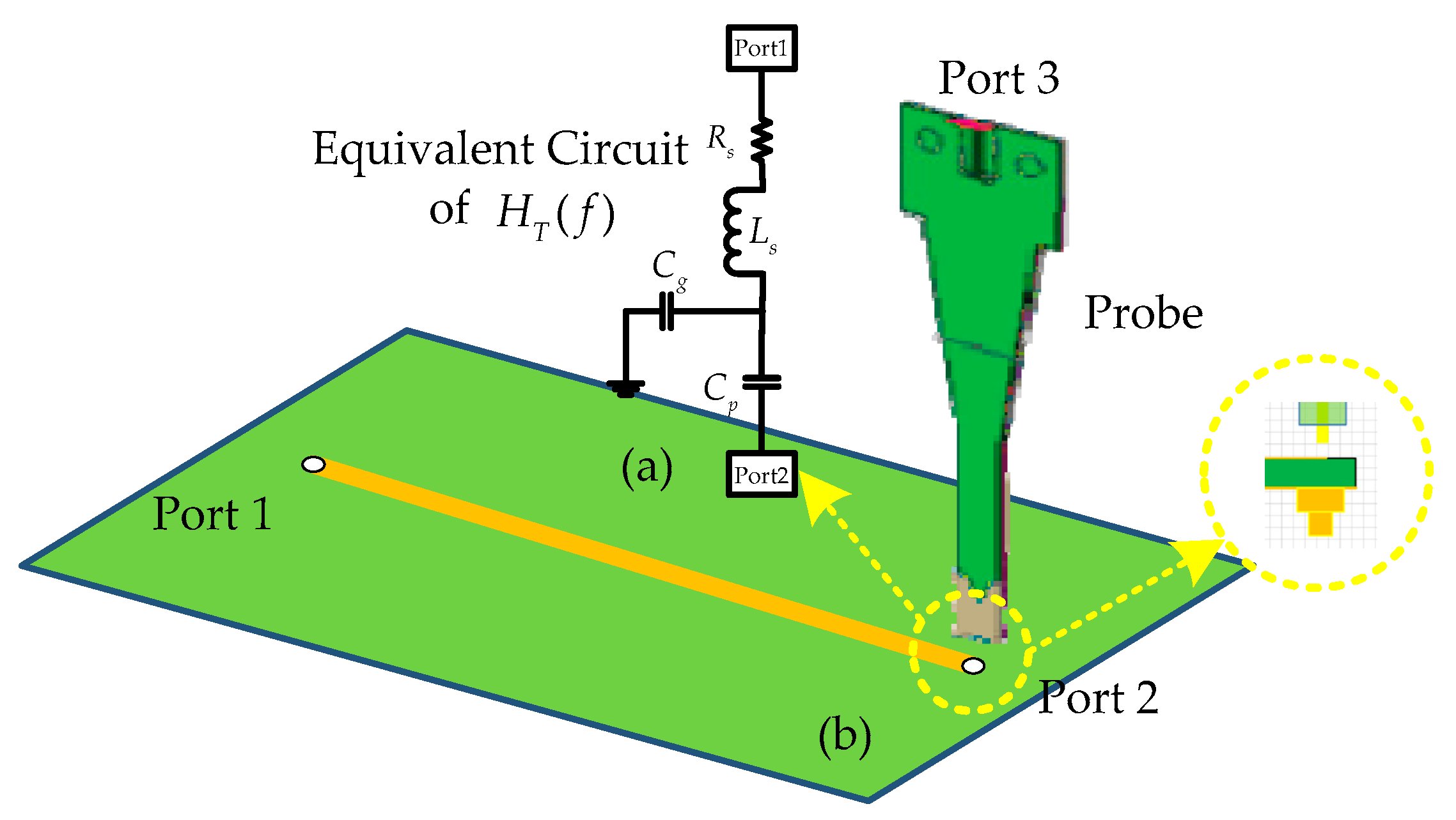
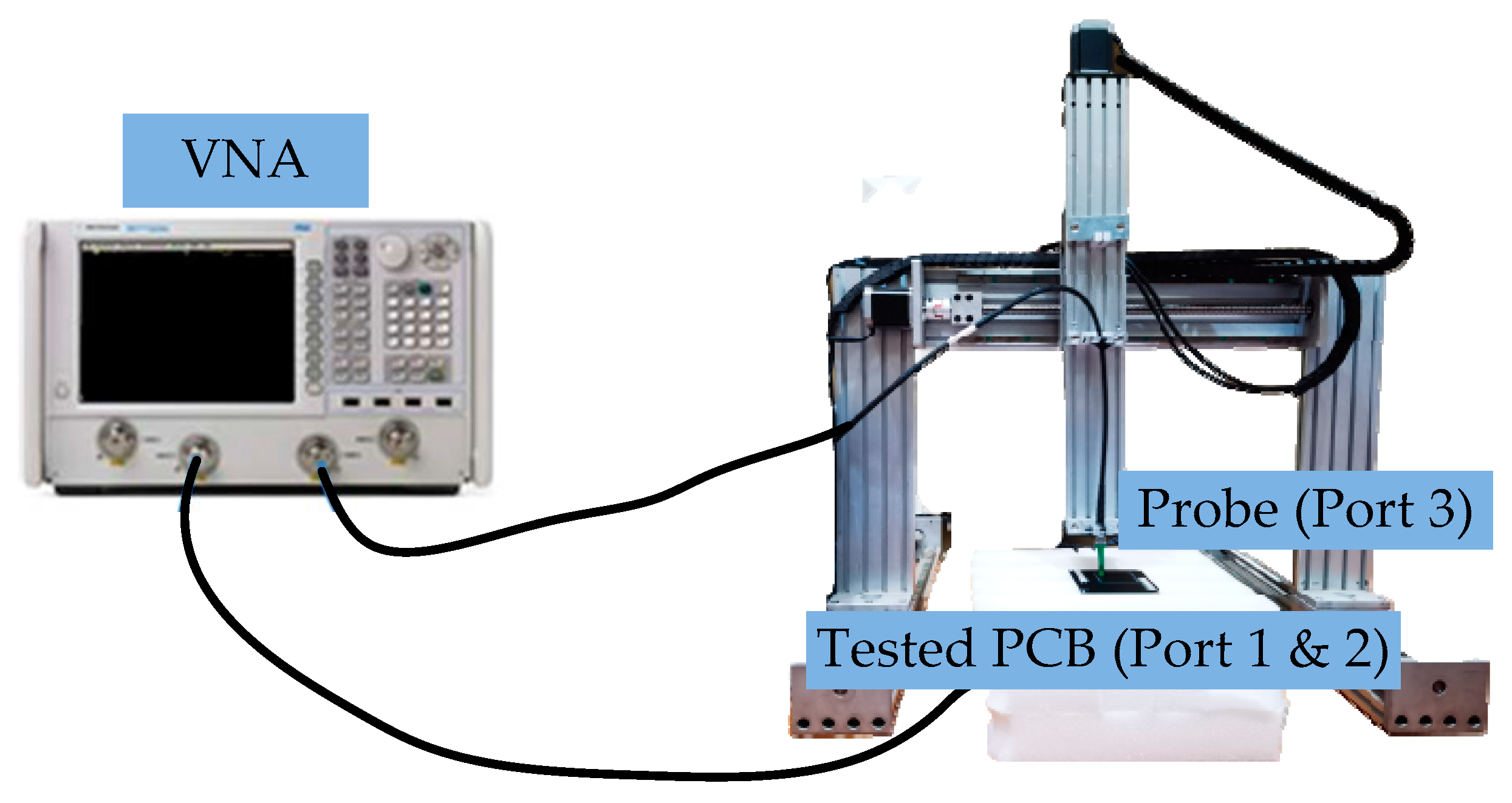
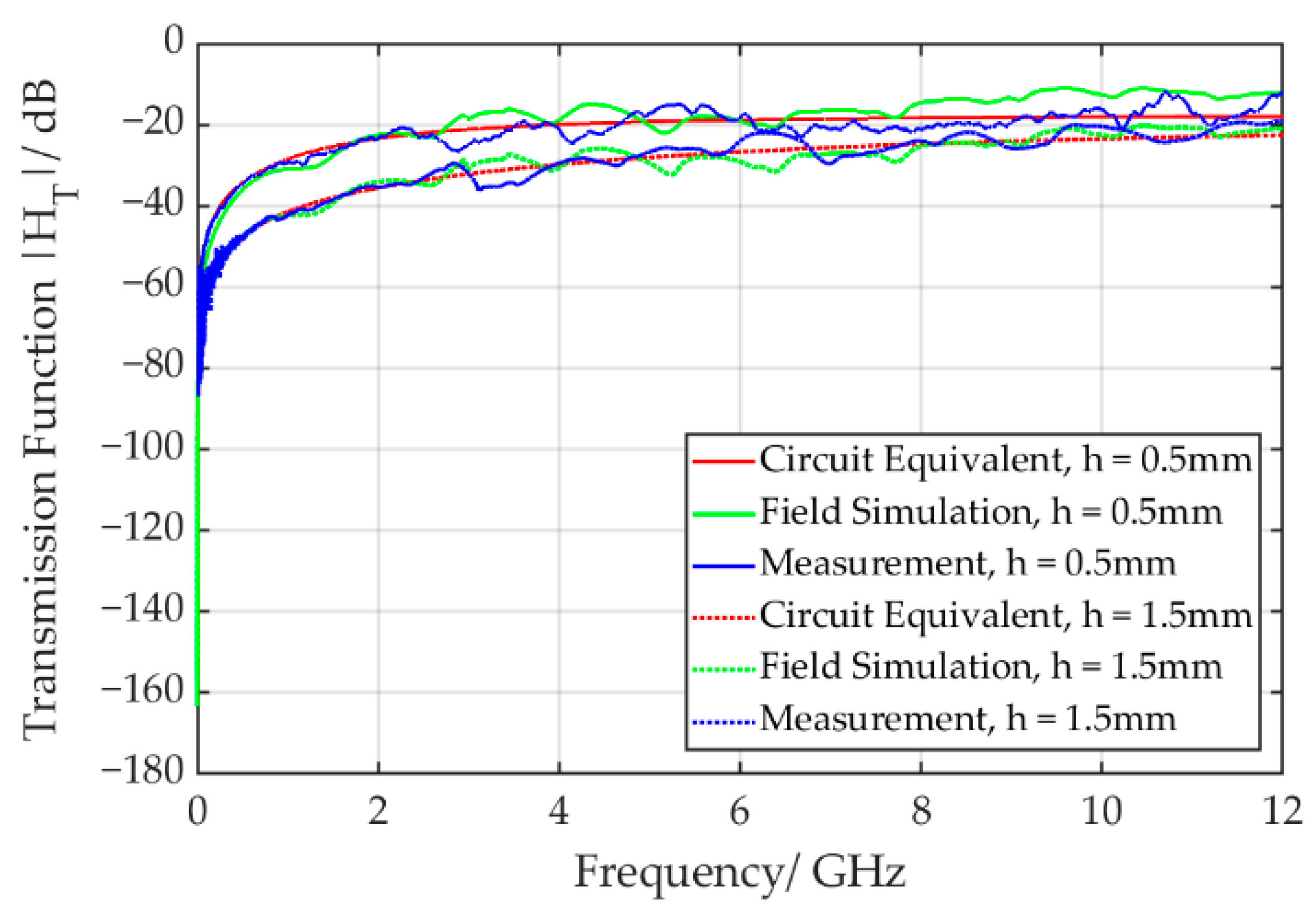
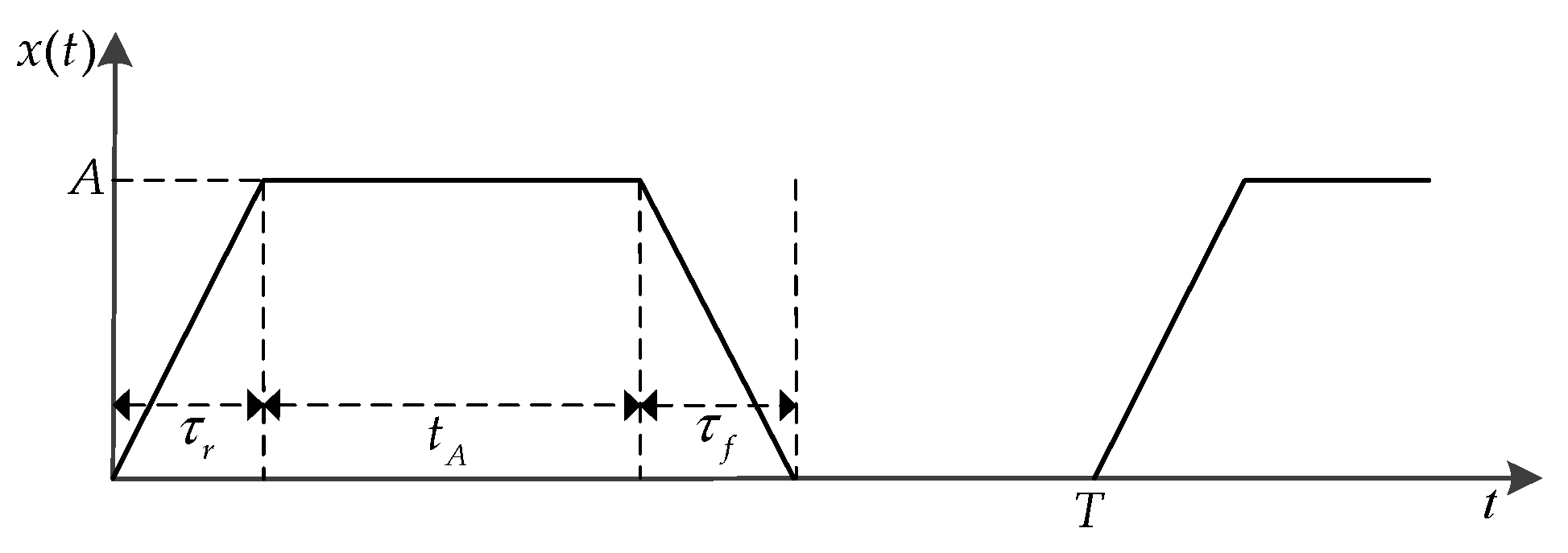
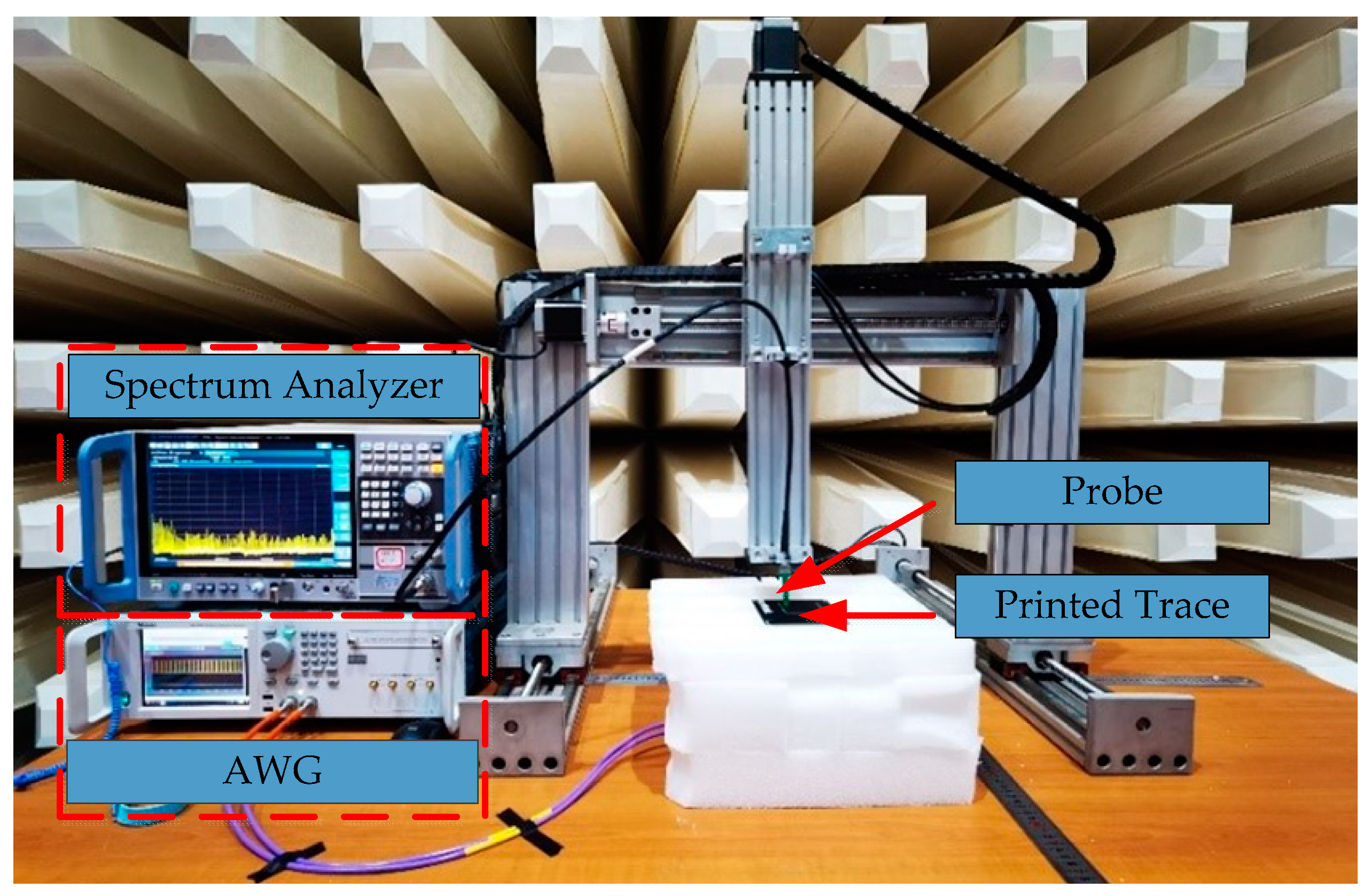


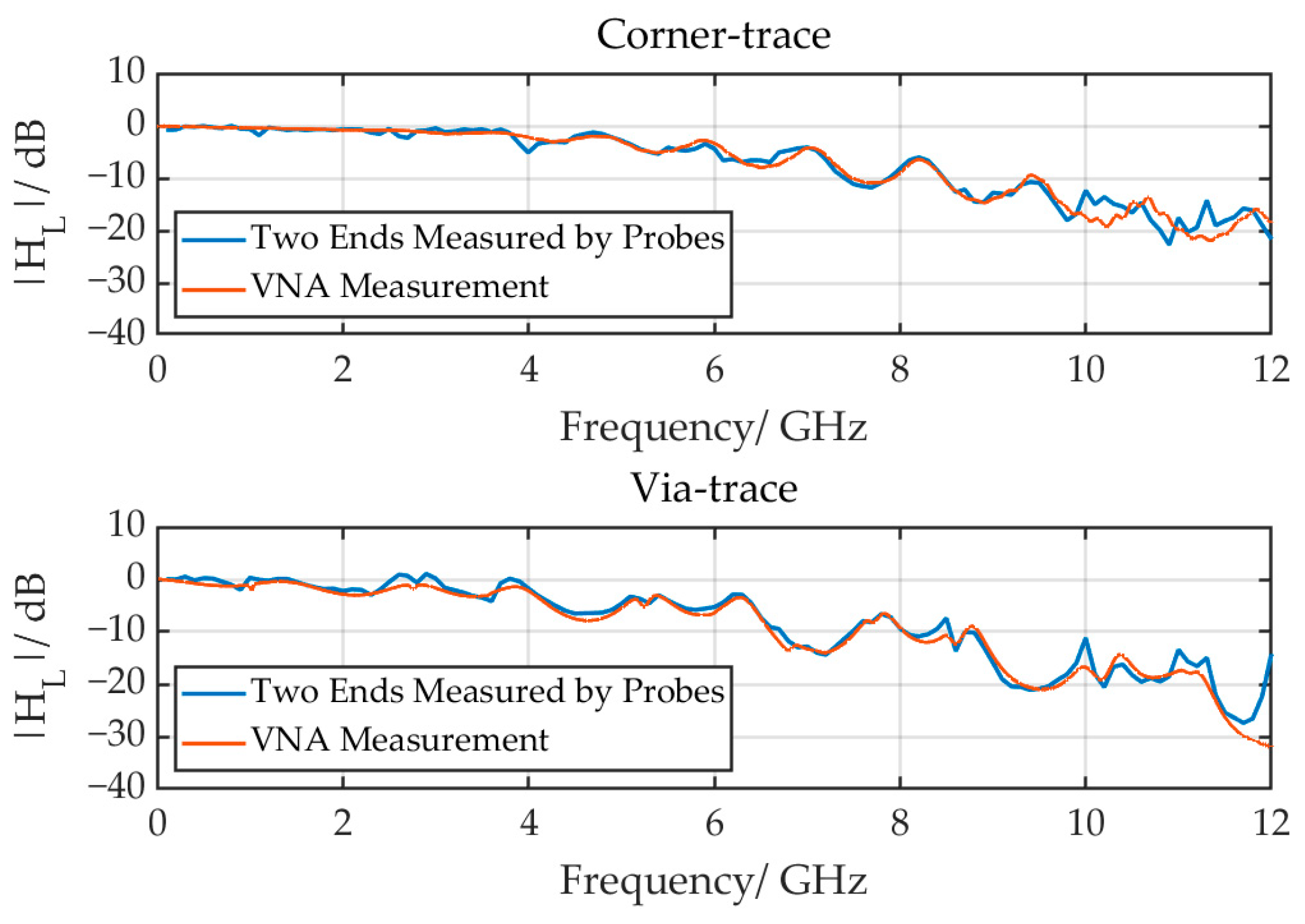
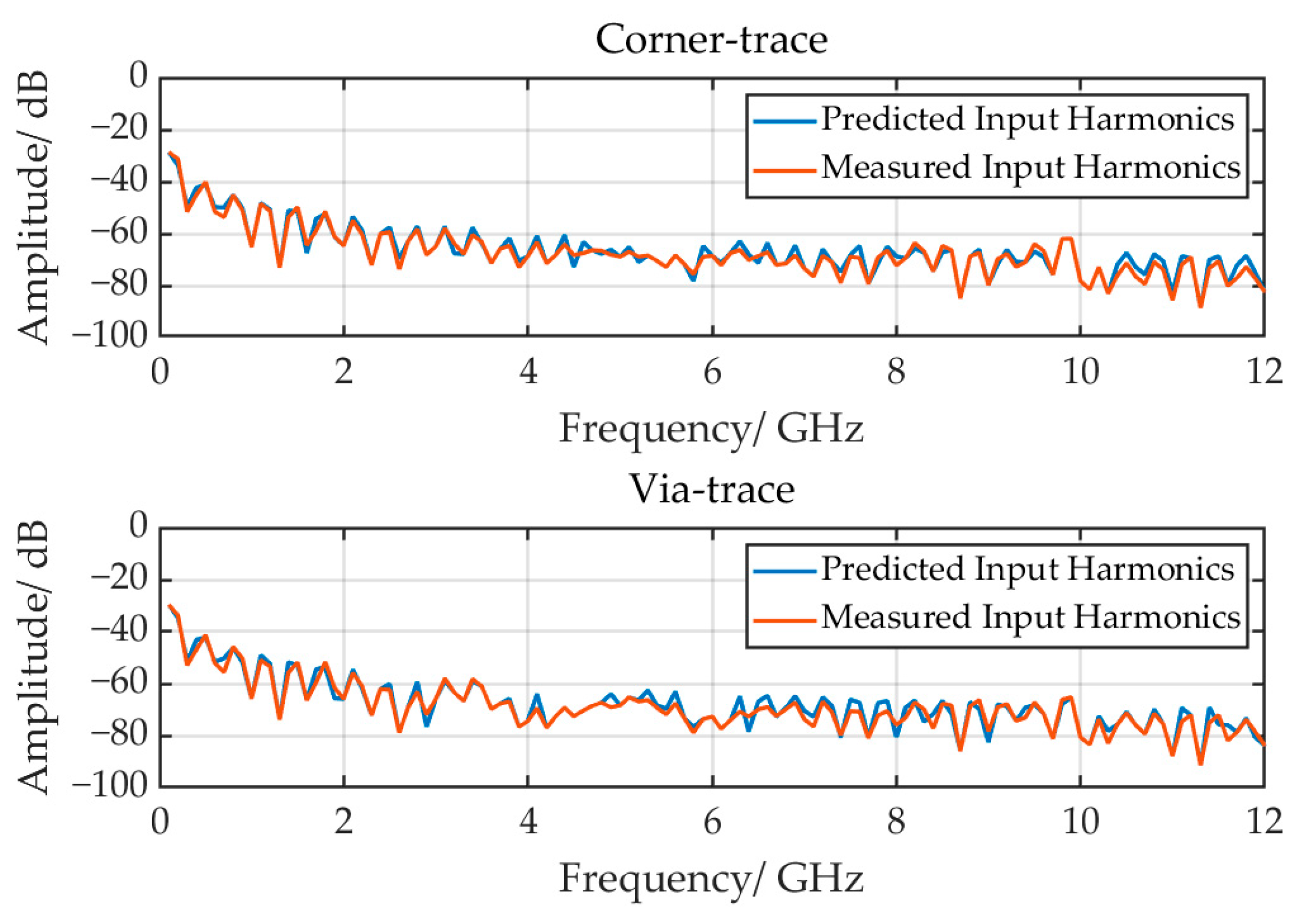
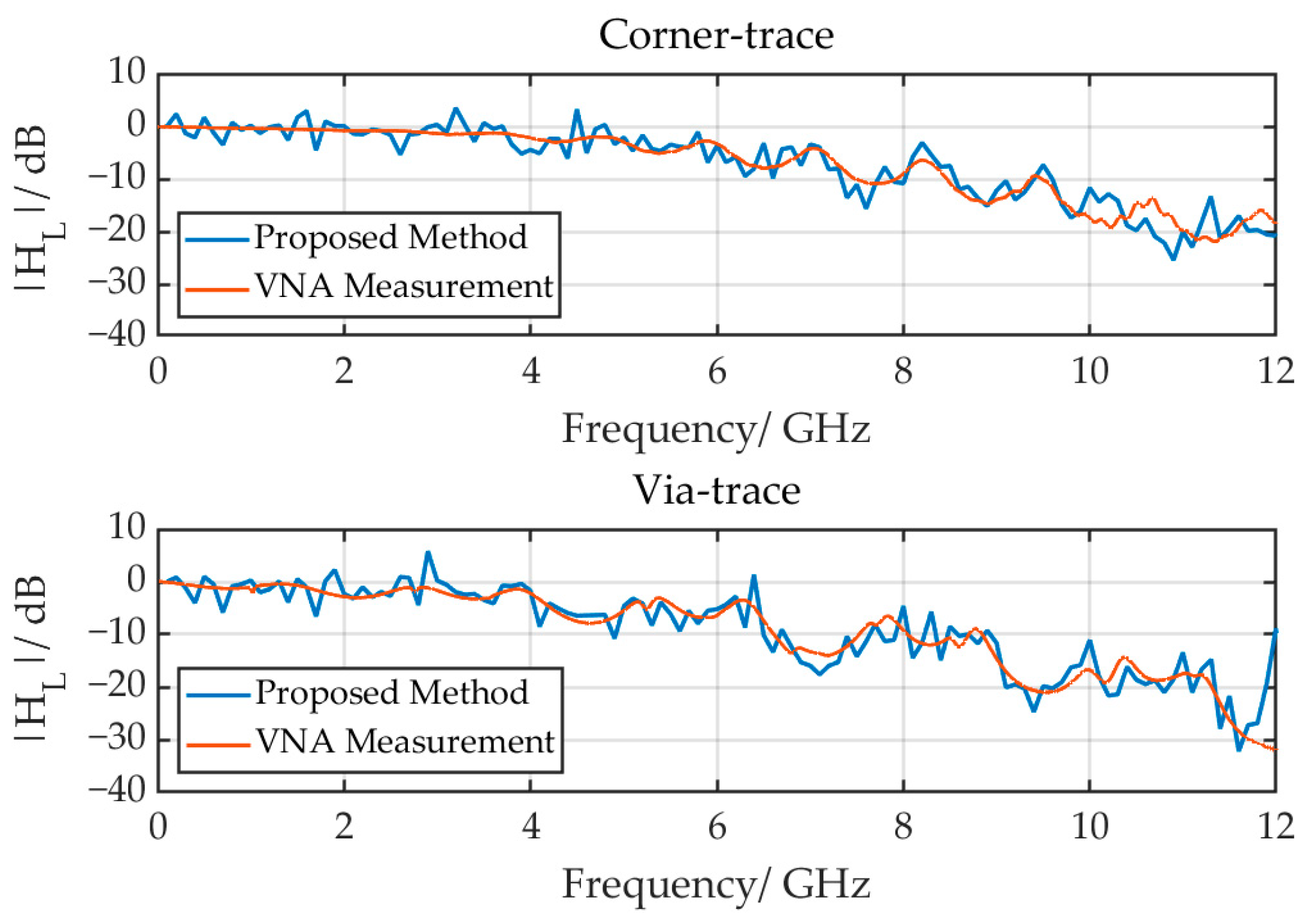
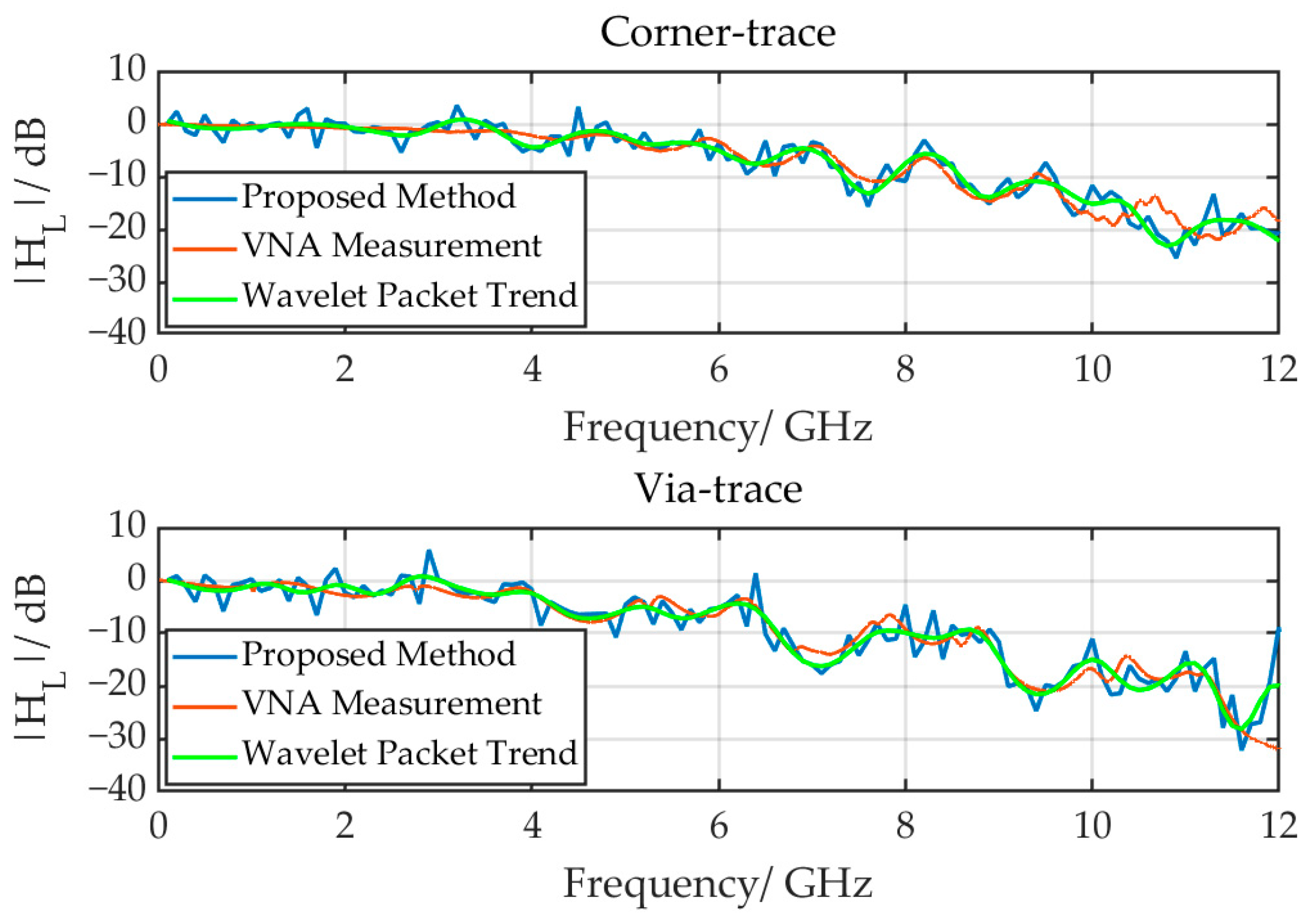

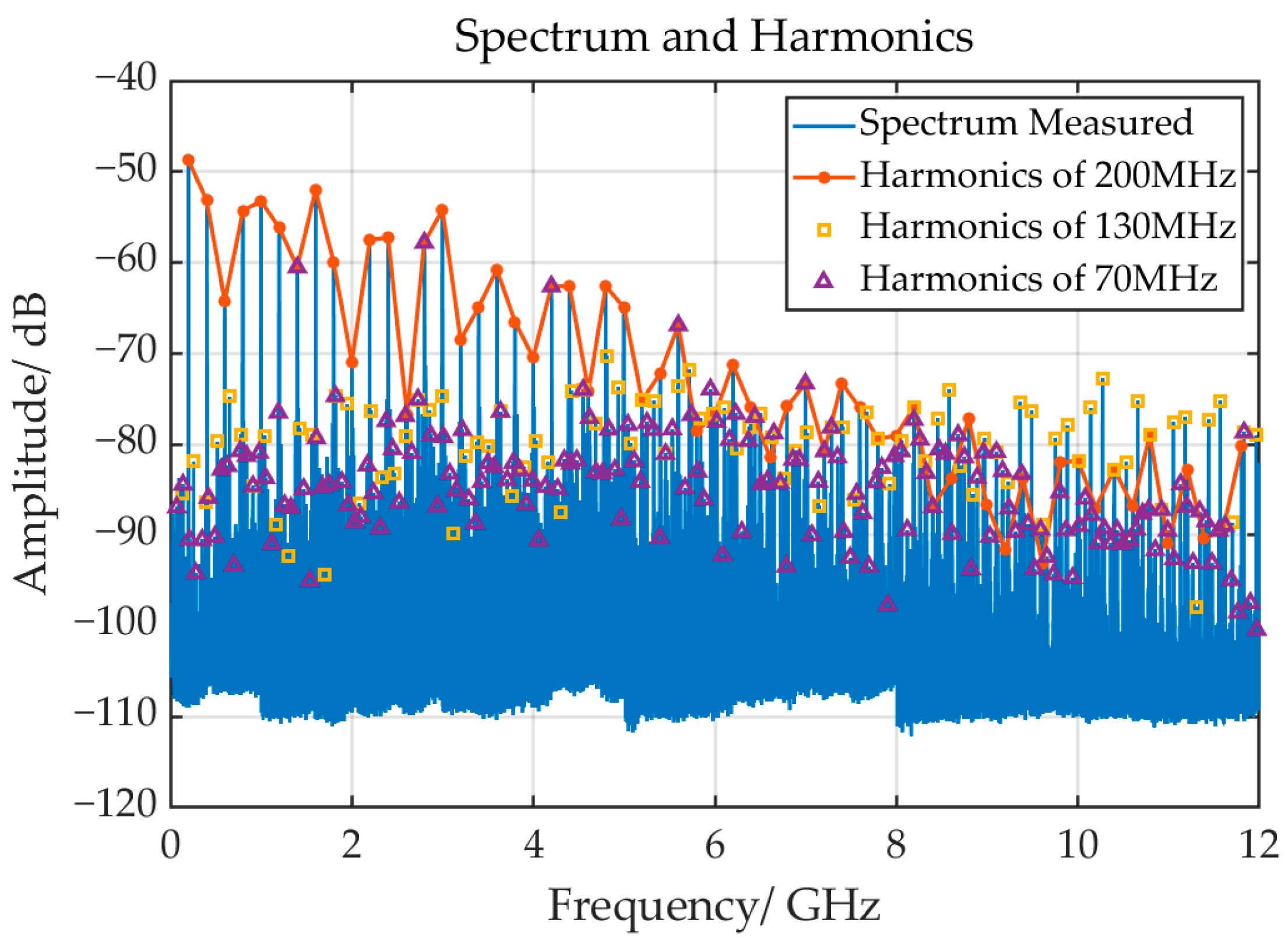

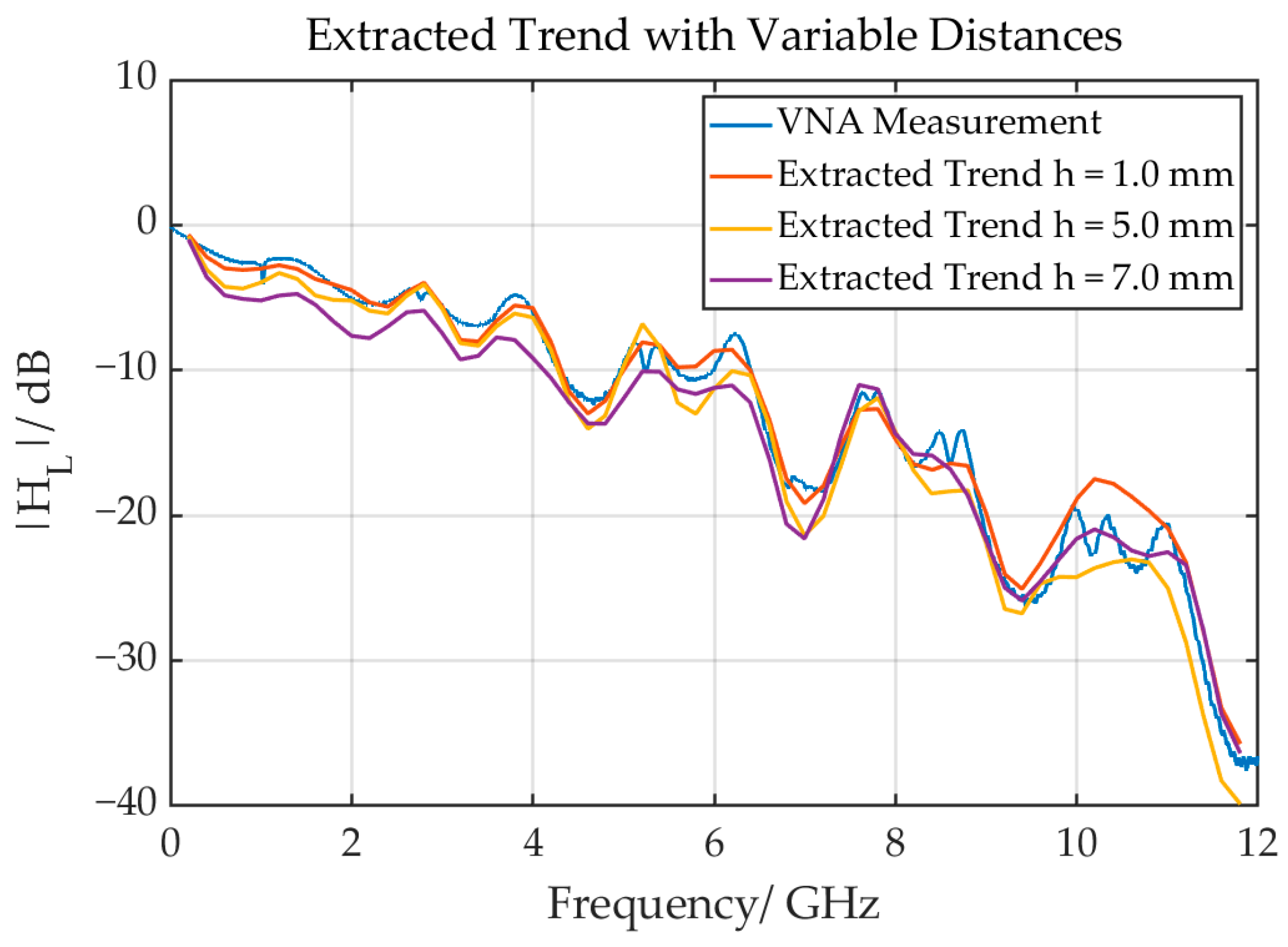
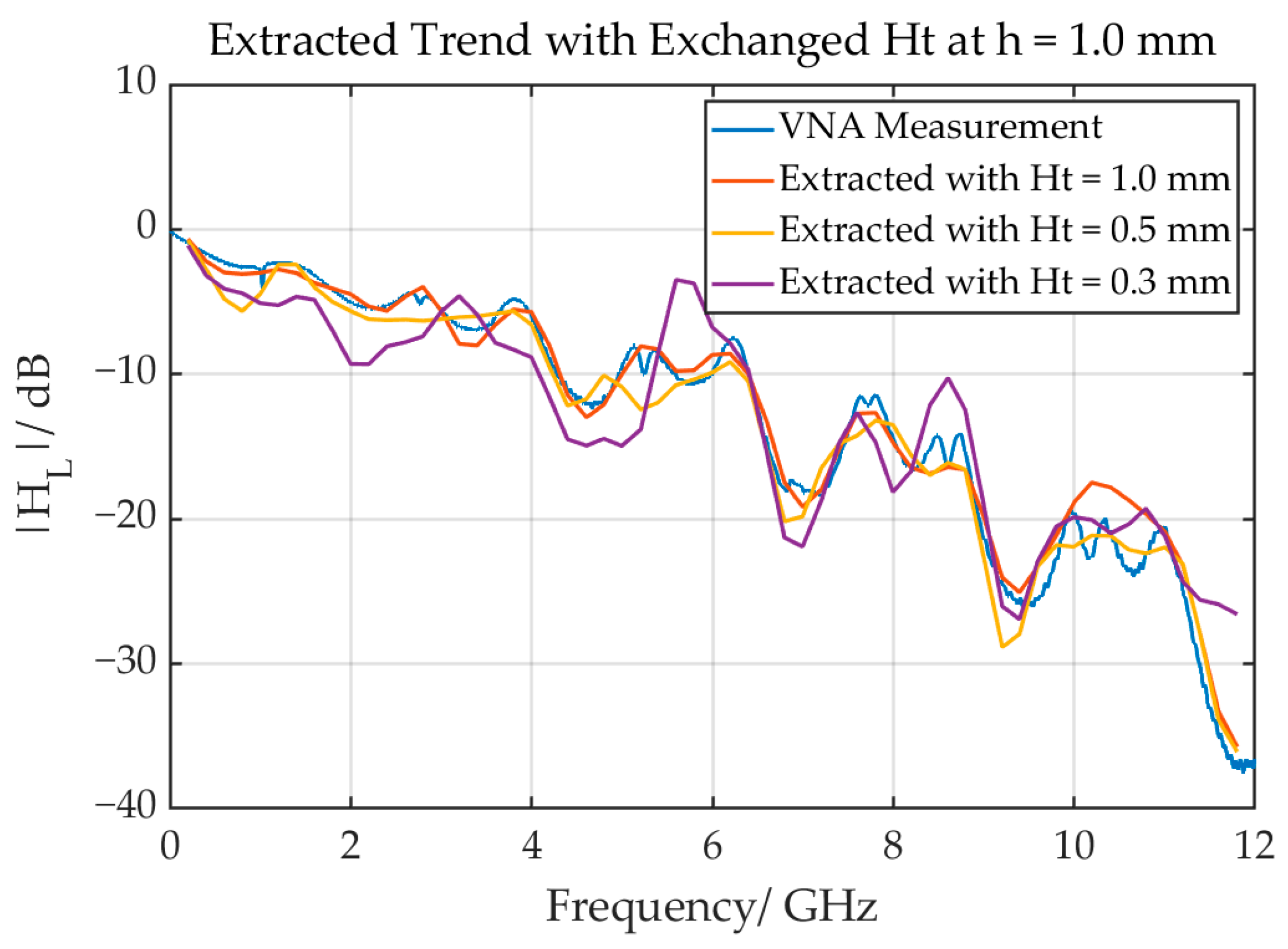

| Items | Preset Values (%) | Extracted Results for 1st–13th (%) | Extracted Results for 8th–20th (%) |
|---|---|---|---|
| 2.00 | 1.94 | 2.01 | |
| 30.00 | 30.08 | 30.05 | |
| 3.00 | 2.95 | 2.98 | |
| Error (%) | 3.0 | 0.5 | |
| 0.27 | 0.17 | ||
| 1.7 | 0.67 |
Disclaimer/Publisher’s Note: The statements, opinions and data contained in all publications are solely those of the individual author(s) and contributor(s) and not of MDPI and/or the editor(s). MDPI and/or the editor(s) disclaim responsibility for any injury to people or property resulting from any ideas, methods, instructions or products referred to in the content. |
© 2023 by the authors. Licensee MDPI, Basel, Switzerland. This article is an open access article distributed under the terms and conditions of the Creative Commons Attribution (CC BY) license (https://creativecommons.org/licenses/by/4.0/).
Share and Cite
Peng, Z.; Xu, H.; Su, D. A Method of Extracting Transmission Characteristics of Interconnects from Near-Field Emissions in PCBs. Appl. Sci. 2023, 13, 2874. https://doi.org/10.3390/app13052874
Peng Z, Xu H, Su D. A Method of Extracting Transmission Characteristics of Interconnects from Near-Field Emissions in PCBs. Applied Sciences. 2023; 13(5):2874. https://doi.org/10.3390/app13052874
Chicago/Turabian StylePeng, Zhenzhen, Hui Xu, and Donglin Su. 2023. "A Method of Extracting Transmission Characteristics of Interconnects from Near-Field Emissions in PCBs" Applied Sciences 13, no. 5: 2874. https://doi.org/10.3390/app13052874
APA StylePeng, Z., Xu, H., & Su, D. (2023). A Method of Extracting Transmission Characteristics of Interconnects from Near-Field Emissions in PCBs. Applied Sciences, 13(5), 2874. https://doi.org/10.3390/app13052874





